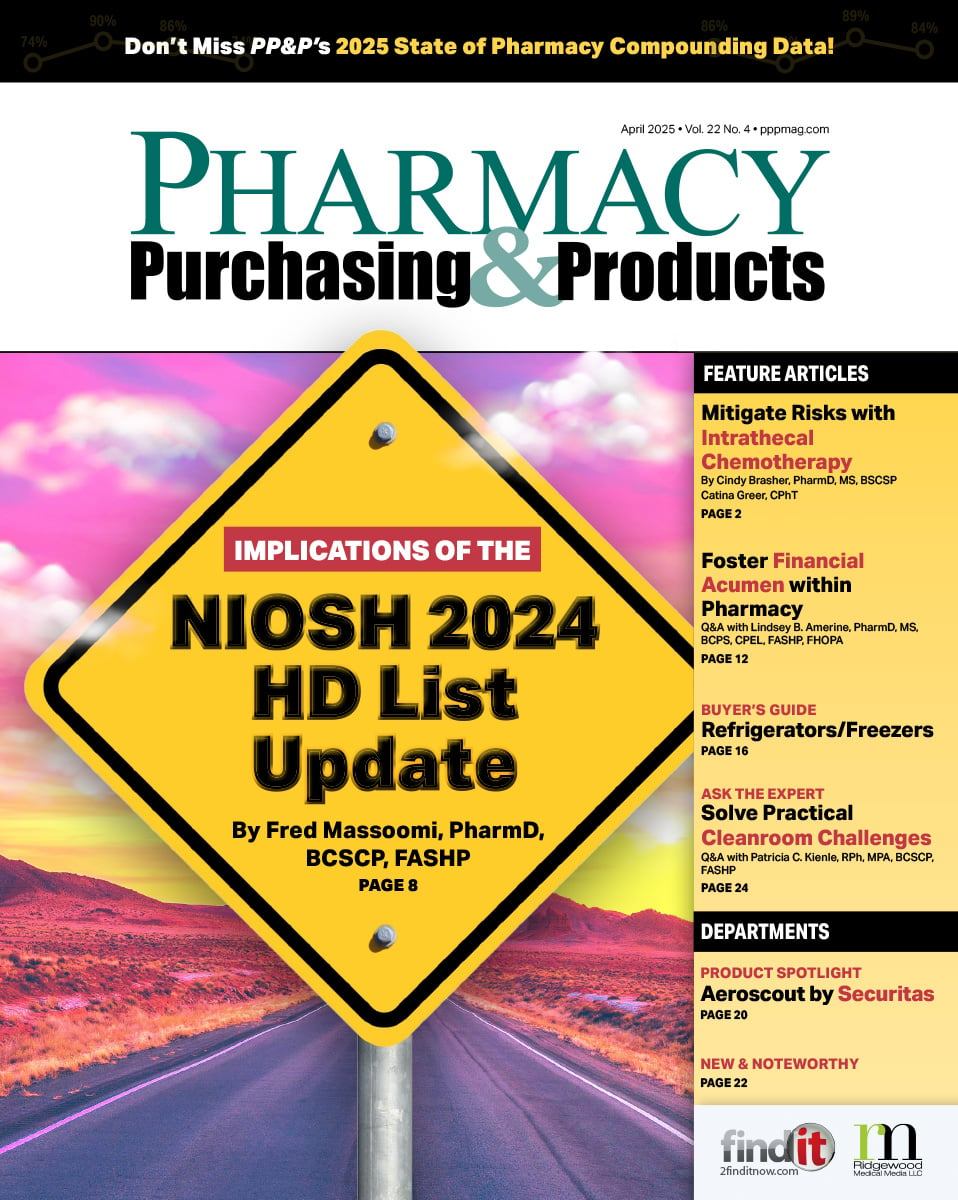- Show Menu
- Contact Us
- FAQs
- Reader Service
- Survey Data
- Survey Winners
- Testimonials
- Upcoming Events
- Webinars
- White Papers
Practical Solutions to Outpatient Pharmacy Management
Q&A with Jessie Morgan, RPh, MHA
Manager of Outpatient Pharmacy Services
University of Louisville Hospital
Pharmacy Purchasing & Products: What is the best approach to selling hospital administration on the value of an outpatient pharmacy?
Jessie Morgan: The pharmacoeconomic value and the patient and employee benefits are the most important considerations. At the University of Louisville Hospital we created a revenue stream from ED and discharge prescriptions. In our pharmacy computer system we identify the patient base and tally the numbers at the end of the month; the figures are then reported to accounting. We also provide incentives for employees to fill their prescriptions at the outpatient pharmacy. Motivating a high volume of employees to use the in-house pharmacy is key to its long-term success. I am actively involved as part of the team that negotiates employee benefits, and we were able to contract with our pharmacy benefit manager to establish lower copays for employees using the outpatient pharmacy.
For example, copays for prescriptions filled at a retail pharmacy generally follow a four-tier pricing structure: $15, $25, $50, and then 25% of the calculated price from the pharmacy benefits management company. The same prescriptions filled at our outpatient pharmacy typically cost the employee just $3, with the exception of tier-four drugs, which are billed at a flat $50. Since our facility is self-funded and there were many employees who were electing not to take advantage of tier-four medications because of price, our human resources department decided that the best value would be to provide the medications at the $50 level.
So, the pharmacy benefit to employees is dramatic. We present this program at new employee orientations so every staff member is aware that they are eligible for these benefits.
An added value of opening an outpatient pharmacy is that it allows pharmacy to be actively involved in medication therapy management programs. With these services we can improve outcomes while reducing medication-related adverse events. We are currently building a diabetes program, and soon will expand our medication therapy management services to cover COPD as well. By driving business to the outpatient pharmacy, we can ensure these patients are filling their prescriptions regularly. The collegial relationship enjoyed between the distributive pharmacists and the clinical pharmacists providing the medication therapy management services leads to better outcomes for our patients. As a result of these programs, we are seeing reduced cardiovascular visits, lower hospitalization rates, and decreases in absenteeism, all of which contribute to better quality of life for our patients.

PP&P: How do you manage the outpatient drug inventory?
Morgan: Because we are a public health service hospital, we order through the 340B program as well as our GPO; however, the inventory is not bundled with our inpatient pharmacy—they are completely separate. We are able to use 340B pricing in the outpatient area and not in the inpatient area, except for outpatient procedures.
Our facility has multiple outpatient pharmacies. One dispenses to the indigent population, and thus is a closed pharmacy without any non-340B prescriptions, which simplifies the ordering process. In the other locations, 340B and our GPO prices are segregated via our computer software program, and the stock is also separated physically. One of the issues we deal with is shortages; when we run out of a product, it can be difficult to access 340B pricing for the replacement product. We deal with this by purchasing the next least-expensive product in the same price category.
Another challenge is ensuring that patients qualify for 340B. The litmus test for 340B pricing is that patients must have a current medical record within the facility. Pharmacy personnel retrieve that information from the hospital systems to ascertain if patients fulfill the qualifying criteria.
PP&P: How do you manage drugs used only in the outpatient setting?
Morgan: We take a flexible formulary approach. Because physicians in the clinics usually write the same prescriptions consistently and approximately half of our patients are financially challenged, we created a formulary for prescribers that makes the management of commonly used drugs simple. The formulary covers most of the common disease states, and also matches, as much as possible, retail pharmacy special prices so that prescribers can use one formulary that covers most of their options.
The criteria used for the outpatient formulary is basically the same process as that used for the inpatient pharmacy; we try to keep the formularies as similar as possible to ensure continuity of care. For example, if an ACE inhibitor is started inpatient, we want to continue the same treatment outpatient to reduce confusion for the patient and providers. We do special order items that are not normally carried in inventory. However, we provide the patient with the retail price before ordering, or the copay price if the patient is covered by insurance, so they can make an informed decision with their provider.
For employees, we will automatically order and stock chronic medications. With acute medications, we direct employees to fill the initial prescription in a retail setting, but we will order any refills necessary.
PP&P: How can you plan the design of an outpatient pharmacy to meet your needs over the long term?
Morgan: It is very important to be cognizant of the need to plan for future growth and incorporate additional space during the design phase. Establishing an algorithm of square feet of storage required by monthly script volume could help this process. Our on-campus ambulatory care pharmacy has been redesigned and expanded three times in the past 10 years, underscoring the importance of considering future growth and incorporating space for future storage space and automation needs in the design.
In the past few years we also have introduced robotic dispensing; ⎯robots now fill and label about 65% of our prescriptions. The use of robots has increased the productivity of the staff, allowing them to spend less time filling prescriptions and instead focus on customer service. Warnings for outpatient-specific medications are now pre-printed on the label, which also saves time and storage space.
Ensuring distribution efficiency is definitely a key part of the design process. Of late, we have made significant changes in emphasizing patient communication and education; by increasing the amount of interaction with patients, we can ensure safer medication use. In hindsight, I wish we had foreseen the growing need for additional medication therapy management counseling rooms. The exponential growth of specialty products also has left us looking for additional storage space. So clearly it is key to plan not only for forecasted growth but also to leave sufficient space to accommodate unexpected future developments.
Jessie Morgan, RPh, MHA, is currently the manager of outpatient pharmacy services at University of Louisville Hospital. He is responsible for oversight of three ambulatory care pharmacies and also oversees a staff of medication access coordinators. Jessie precepts learners at all levels of study in pharmacy and is passionate about delivering care to patients and internal stakeholders at the platinum level of service.
Like what you've read? Please log in or create a free account to enjoy more of what www.pppmag.com has to offer.








